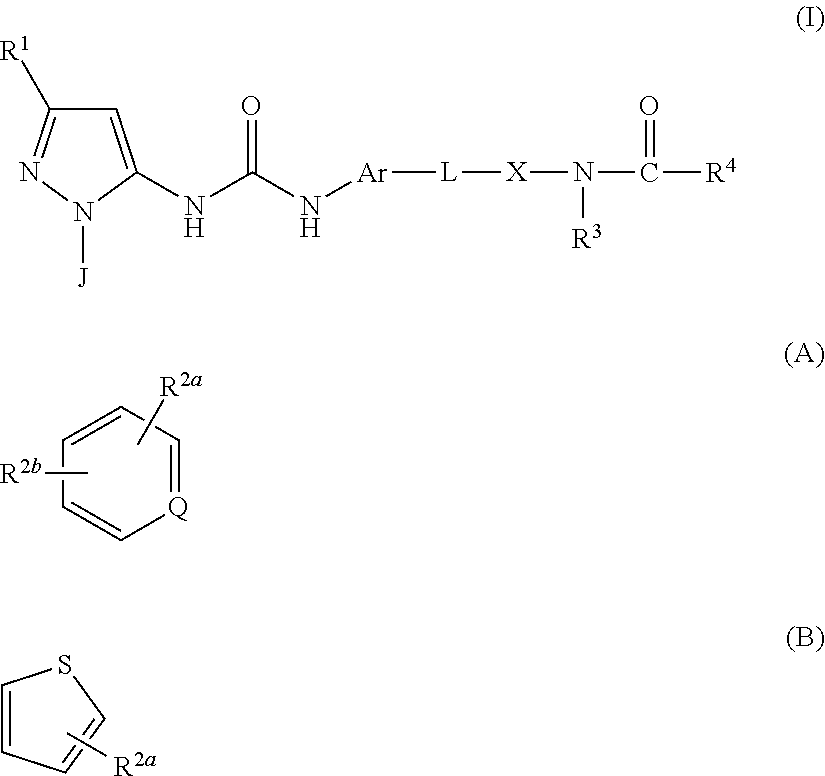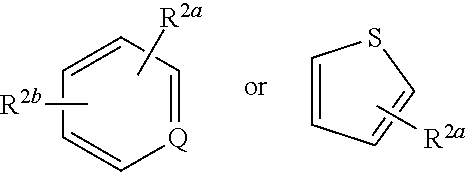P38 MAP Kinase Inhibitors
a kinase inhibitor and map technology, applied in the field can solve the problems of affecting the phosphorylation of p38 mapks or jnks, affecting the utility of p38 map kinase inhibitors in the treatment of human chronic inflammatory diseases, and early generations of compounds were highly toxi
- Summary
- Abstract
- Description
- Claims
- Application Information
AI Technical Summary
Benefits of technology
Problems solved by technology
Method used
Image
Examples
example 1
N-(4-(4-(3-(1-(4-Aminophenyl)-3-tert-butyl-1H-pyrazol-5-yl)ureido) naphthalen-1-yloxy)pyridin-2-yl)-2-methoxyacetamide
[0531]
[0532]To a suspension of CDI (301 mg, 1.86 mmol) in DCM (4.0 mL) was added Intermediate A3 (483 mg, 1.86 mmol) and the reaction mixture maintained at RT for 16 hr. A solution of Intermediate B1 (260 mg, 0.80 mmol) in DCM (2.6 mL) was added and after a further 24 hr at RT the reaction mixture was partitioned between DCM (20 mL) and water (20 mL). The organic layer was separated and was washed with brine (20 mL) and then dried and evaporated in vacuo. The residue was purified by flash column chromatography (SiO2, EtOAc in isohexane, 30-100%, gradient elution) to afford N-(4-(4-(3-(3-tert-butyl-1-(4-nitrophenyl)-1H-pyrazol-5-yl)ureido)naphthalen-1-yloxy)pyridin-2-yl)-2-methoxyacetamide as a pale brown solid (290 mg, 50%); Rt 5.12 min (Method 1 basic); m / z 610 (M+H)+ (ES+).
[0533]A solution of N-(4-(4-(3-(3-tert-butyl-1-(4-nitrophenyl)-1H-pyrazol-5-yl)ureido)naphtha...
example 2
N-(4-(4-(3-(3-tert-Butyl-1-(4-(methylsulfonamido)phenyl)-1H-pyrazol-5-yl)ureido)naphthalen-1-yloxy)pyridin-2-yl)-2-methoxyacetamide
[0534]
[0535]To a solution of Example 1 (42 mg, 0.072 mmol) in DCM (2.0 mL) and DIPEA (26 μL, 0.14 mmol) at 0° C. was added methanesulfonyl chloride (8.0 μL, 0.1 mmol) in DCM (1.0 mL) and the reaction mixture was warmed to RT for 2 hr. Additional aliquots of DIPEA (26 μL, 0.14 mmol) and methanesulfonyl chloride (4.0 μL, 0.05 mmol) were added and after a further 2 hr the reaction mixture was washed with saturated aq NaHCO3 (2.0 mL). The organic layer was separated and evaporated in vacuo and the residue was purified by flash column chromatography (SiO2, EtOAc in isohexane, 20-100%, gradient elution) to afford the title compound, Example 2, as a pale purple solid (24 mg, 48%); Rt 4.00 min (Method 1 basic); m / z 658 (M+H)+ (ES+); 1H NMR (400 MHz, DMSO-d6) δ: 1.27 (9H, s), 3.06 (3H, s), 3.29 (3H, s), 3.98 (2H, s), 6.41 (1H, s), 6.70 (1H, dd), 7.34 (1H, d), 7.3...
example 3
N-(4-((4-(3-(3-(tert-Butyl)-1-(4-methoxyphenyl)-1H-pyrazol-5-yl)ureido) naphthalen-1-yl)oxy)pyridin-2-yl)-2-methoxyacetamide
[0536]
[0537]To a suspension of CDI (130 mg, 0.80 mmol) in DCM (1.5 mL) was added Intermediate A6 (197 mg, 0.804 mmol) and the reaction mixture maintained at RT for 2 hr. An aliquot of this solution (500 μL, 0.30 mmol) was added to a solution of Intermediate B1 (65 mg, 0.20 mmol) in DCM (1.5 mL) under N2 at 0° C. and the reaction mixture was warmed to RT. Further portions of CDI adduct were added after 4 hr (500 μL, 0.30 mmol) and after 21 hr (200 μL, 0.10 mmol) and after a total of 23 hr the reaction mixture was partitioned between DCM (15 mL) and saturated aq. NaHCO3 (15 mL). The aq layer was separated and extracted with DCM (15 mL) and the combined organic extracts were washed with brine (15 mL) and then dried and evaporated in vacuo. The residue was purified twice by flash column chromatography (SiO2, 12 g, [5% MeOH in EtOAc] in isohexane, 0-55%, gradient el...
PUM
| Property | Measurement | Unit |
|---|---|---|
| Volume | aaaaa | aaaaa |
| Volume | aaaaa | aaaaa |
| Volume | aaaaa | aaaaa |
Abstract
Description
Claims
Application Information
 Login to View More
Login to View More - R&D
- Intellectual Property
- Life Sciences
- Materials
- Tech Scout
- Unparalleled Data Quality
- Higher Quality Content
- 60% Fewer Hallucinations
Browse by: Latest US Patents, China's latest patents, Technical Efficacy Thesaurus, Application Domain, Technology Topic, Popular Technical Reports.
© 2025 PatSnap. All rights reserved.Legal|Privacy policy|Modern Slavery Act Transparency Statement|Sitemap|About US| Contact US: help@patsnap.com



